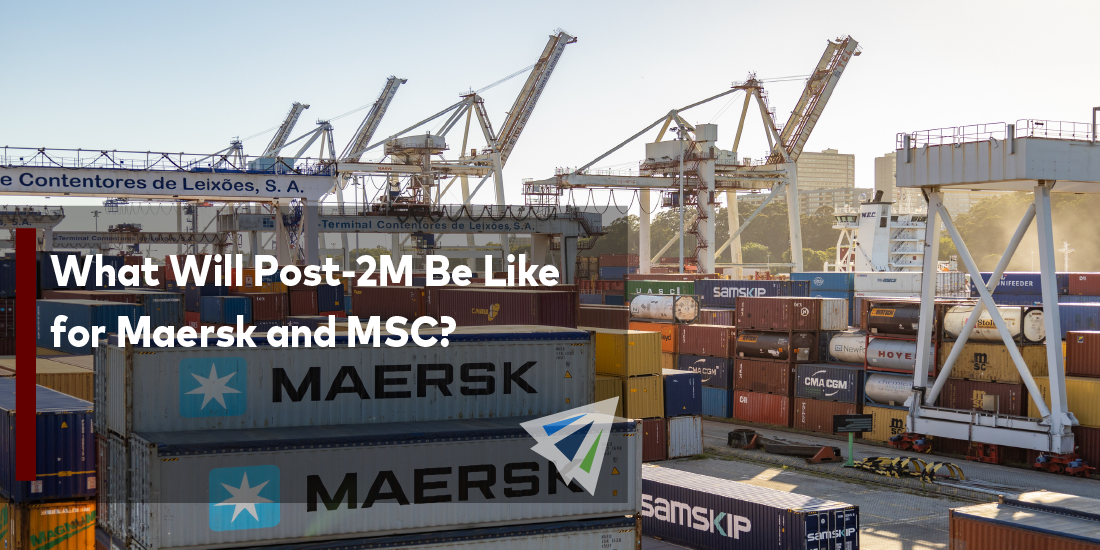A recent shipping line shakeup has been one for the books. Last month, Maersk and MSC, the world’s two largest lines, announced their 2M Alliance will be terminated, effective January 2025. The big move comes as the two shipping giants “pursue individual strategies” with their respective businesses.
The decision to terminate the alliance has no immediate effect on current 2M services with both carriers assuring cooperation through the January 2025 end date.
An once superstar alliance
The impending termination signals the close of the vessel sharing agreement (VSA) between Maersk and MSC, introduced back in 2015. With the agreement honoring a ten-year minimum term, the January 2025 date is not arbitrary and represents when it’s obligatory for the two parties to part ways.
At the time of 2M’s formation, the two shipping lines were on the same page with what exactly a superstar alliance could bring for the industry and their own shipping capacity. In sports terms, it’s like when LeBron James teamed up with Dwyane Wade in South Beach to win not three, not four, not five championships.
The rationale likely was, “Hey, we both have industry-leading fleets and service networks, what if we combined forces and tormented our competition ten-fold?”
For the greater first half of the decade agreement, Maersk and MSC touted the 2M Alliance as a bringer of competitive and cost-effective operations across several trade lanes, including the Asia-Europe, transatlantic, and transpacific markets.
Pandemic-era led to diverging strategies between 2M allies
But then the pandemic came. An event that spin-cycled the industry that surely no one could’ve predicted—much less five years before, when 2M was conceived.
Every stakeholder in logistics saw some sort of reinvention. Shippers, buyers, consumers, intermediaries, governments—you name it.
This was no exception for arguably the biggest fish in the pond—carriers. The pandemic uncovered new direction and afforded room to grow for many shipping lines.
So, it makes sense on why Maersk and MSC announced the phase out of their alliance. The two carriers, bolstered by pandemic-era growth and reimagined strategy, are no longer on the same page with each other.
Maersk set a steady regiment on its fleet capacity opting to focus on broadening its capabilities to become a fully integrated end-to-end service provider. The shipping line made a swarth of acquisitions, including a $644 million purchase of an air freight forwarder, thanks to the insane profits Maersk, and its carrier peers, enjoyed over the last two years.
Meanwhile, MSC narrowed its focus primarily on ocean.
While the carrier made investments to inland logistics, MSC was not fooling anyone on its top priority. It went all in on expanding ocean capacity and became the largest line by tonnage early last year.
The buck doesn’t stop there, either. The shipping line also an outstanding orderbook, more than double of any other carrier, for newbuild capacity. In fact, this order capacity (1.8 million TEUs) is higher than the existing tonnage alone of Hapag-Lloyd.
Hapag-Lloyd, a.k.a the world’s fourth largest shipping line.
MSC has enough capacity to stand alone
Even with 2M’s termination two years away, no doubt a lot of questions have emerged right now.
The two largest shipping lines in the world are both pursuing different strategies. Surely, this has to affect the industry. What exactly can we expect?
Well, for starters, MSC’s capacity quest over the last two years now renders the carrier big enough to stand alone.
In addition to newbuilds on order, MSC acquired a great deal of secondhand vessels as well. Unlike 2015, the world’s largest shipping line no longer needs a partner to support a global trade network. Regarding capacity, MSC can sail the seven seas without a co-captain.
Maersk may pass on alliance formalities
Unlike MSC, Maersk’s acquisitions were based around its focus on becoming an end-to-end integrated logistics provider. That said, the world’s second largest carrier is not in the same position as its soon-to-be-divorced ally is.
As it stands, Maersk’s current network would require the carrier to find a new partner. Without one, there are questions on whether the carrier can provide the same level of service coverage and quality to customers in a post-2M climate.
However, that doesn’t mean Maersk is bound to join or start a new alliance.
The carrier is active in over 40 VSAs across the globe (albeit none as big as 2M) and has hinted at its strategy to continue with these sort of arrangements as 2M draws to a close.
Many speculate Maersk may pass on alliance formalities altogether, opting for a more robust network of VSA partners in niche markets. From there, the carrier will root itself in key markets where its end-to-end logistics can thrive.
Even if Maersk pursues a formal alliance, regulatory challenges may prove difficult for the carrier. In other words, Maersk can’t simply jump ship onto other contractually committed pairings, like THE Alliance or Ocean Alliance, without there being any pushback.
Final Thoughts
The 2M Alliance is a complex partnership that extends across all major trade lanes. Some 30 loops and strings are operated by MSC and Maersk under this agreement.
The decision to terminate the agreement two years ahead of the effective date should afford these carriers valuable time to orient themselves in right direction when they each walk away from the other in 2025.
Please contact our team if you have any questions or concerns on how this may impact your shipping.
In addition, our weekly market updates are a great way to stay up to date on all things logistics. From trade lane updates to relevant freight news, it’s a one stop shop for your industry fix!
